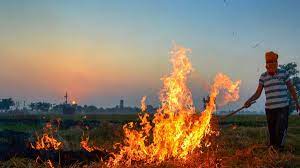WASHINGTON: Stubble-burning, which is a major source of air pollution in the national capital region every winter, is a solvable problem, said Indian-American Punit Renjen, the Deputy Chair of German software firm SAP, based on the two pilot projects he has launched in Haryana and Punjab.
“It is very serious and there are multiple reasons for it. But stubble-burning contributes about 25 per cent to 30 per cent of the air quality issues (in Delhi). There are 80,000 fire incidents in northern India, particularly in Punjab, Haryana, and Uttar Pradesh. About 13 million tonnes of stubble is burned and 19 million tonnes of carbon dioxide and other harmful gases are put into the atmosphere,” Punit Renjen told reporters.
The top Indian-American CEO, who has made part of his mission to help fight air pollution in the national capital region, said 15 million adjusted life years is equivalent to 2 lakh people dying each year as a result of stubble-burning.
“There’s USD 300 million of lost revenue,” Renjen, who is also the Global CEO Emeritus of Deloitte, said.
“It’s a big issue impacting the air quality in northern India, Delhi and elsewhere. And it can be addressed. And this is the issue. It is a solvable problem,” he said.
Renjen said for the last two years he has been working collaboratively with the government of Haryana and has mitigated stubble-burning.
“This year, we are working in 660 villages in nine districts that comprise 91 per cent of active fires in Haryana, a 58 per cent reduction in fire incidents. So, it is a solvable problem. We’re also working in one district in Punjab Patiala to try and demonstrate that our programme can address this issue,” he said.
A collaborative effort between business and government, the programme has five elements, Renjen noted.
“The first is engagement and communication with the farmers. The second is leveraging technology. We’ve developed an app, the Krishi Yantra Sathi, which connects farmers with equipment providers, with end users,” he said, adding that the app is almost like ordering an Uber.
“But it orchestrates, if you will, linking the farmers with the providers of equipment and the end users of the stubble. Now here’s the issue. There is a very short window that the farmers have in between when they harvest the paddy crop and when they have to plant the winter crop. And the easiest answer is the 1 cent match that lights the stubble on fire, but it is absolutely destructive,” he said.
“The third is orchestration. We are orchestrating this whole programme. The fourth is an ecosystem that we’ve developed between equipment manufacturers, and end users. And then the fifth and final is to leverage the government and business,” he explained.


